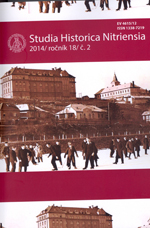Studia Historica Nitriensia, 2014, roč. 18, č. 2:
Obsah/Contents/Inhalt
Štúdie a články/Articles/Studien
Author: Niklová Michaela
Title: Pohreby a pohrebné zvyky kultúry s lineárnou keramikou na území juhozápadného Slovenska
Authors: Janura Tomáš – Havlík Marián
Author: Kamenčík Marián
Title: Veršované svedectvo Pavla Vajaja o povodni na Váhu v roku 1813
Author: Vrbata Aleš
Title: Late Portuguese Colonialism and Freyre’s Lusotropicalismo
Author: Jůva Vladimír
Title: K teoretickým východiskům muzejní pedagogiky
Author: Šobáňová Petra
Title: Předpoklady spolupráce muzea a školy – prezentace výsledků výzkumného šetření
Authors: Dirner Alexander – Hlaváčová Júlia – Mešterová Jana – Labanič Eugen – Schwartzová Agnesa
Title: Vedecko – technické centrum pre mládež v Košiciach
Author: Jakubej Ján
Author: Kičková Adriana
Title: K problematike riadiacich orgánov školstva na Slovensku po roku 1918
Recenzie /Review /Kritik
ARPÁŠ, Róbert. Autonómia: víťazstvo alebo prehra? Vyvrcholenie politického zápasu HSĽS o autonómiu Slovenska. (Martin Hetényi)
Anotácie / Annotations/ Glossen
HANUŠ, Jiří et al. Nostalgie v dějinách. (Ľudovít Marci)
JIRKAL, Emanuel. L. Caelius Firmianus Lactantius. O smrti prenasledovateľov I. Rímske impérium na ceste od tradičných kultov ku kresťanstvu. (Ľudovít Marci)
BENJAN, Milan B. Kultúra Západu v agónii. O európskom maliarstve a estetike od renesancie až po ich exitus a o západnej civilizácii vo svetle biblických proroctiev. (Ján Jakubej)
MAK, Geert. V Evropě. Cesty po dvacátém století. (Ľudovít Marci)
Deviant Burial in the Archaeological Record. Ed. E. Murphy. (Zuzana Ďuďáková)
Kronika/Chronicle/Chronik
